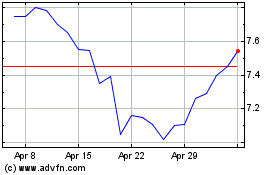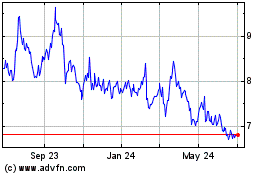QUERÉ TARO, Mexico—Jody Fledderman is one of five original
employees at the auto-parts factory his father founded in rural
Batesville, Ind. He also spends a lot of time at the company's
97,000-square-foot plant in central Mexico.
The two operations have expanded together as automotive
production in both countries boomed. Mr. Fledderman credits the
success of Batesville Tool & Die Inc., where he is president,
in part to the addition of a Mexican plant 16 years ago that helps
service Honda Motor Co., Nissan Motor Co. and other clients on both
sides of the border.
"We have three or four clients back in Indiana that we wouldn't
have had if we weren't here," Mr. Fledderman, 54 years old, said in
an interview at the plant in Queré taro.
President-elect Donald Trump has said that in his first days in
office he will reopen talks on the North American Free Trade
Agreement, which connects Canada, the U.S. and Mexico, and leave
the pact if Mexico doesn't agree to improved terms for the U.S. He
blames unfair trade, in particular with Mexico and China, for the
loss of millions of factory jobs.
Ending the 1994 trade pact is relatively easy. The U.S. legally
can pull out of Nafta six months after Mr. Trump as president
notifies Mexico and Canada of his intention to do so, according to
a September study by the Peterson Institute for International
Economics in Washington. Imposing tariffs on imports lies within
the authority of U.S. presidents.
For the auto industry, as Mr. Fledderman's business shows, such
a change would be substantially more complicated, because of the
multilayered connections between U.S. and foreign suppliers and
assembly points. The tens of thousands of parts that make up any
vehicle often come from multiple producers in different countries
and travel back and forth across borders several times.
This is a tenet of modern manufacturing: Where a product is
ultimately assembled increasingly has little bearing on where its
component parts are made.
Assembly plants are prized engines of a local economies because
they tend to pay better than most factories. Mr. Trump has
repeatedly criticized Ford Motor Co.'s plan to move assembly of its
Focus compact from Wayne, Mich., to Mexico, vowing to impose a
steep tariff on the car if Ford follows through. Ford executives
have said moving the Focus to Mexico won't result in American job
losses and that the company remains committed to producing in the
U.S.
But more than half the parts in the Focus today are made outside
the U.S. and Canada, including 20% in Mexico. Ford also ships in
some of the car's engines from Spain and transmissions from
Germany.
Similarly, only 10% of the parts that go into the 200,000 BMW
luxury crossovers built each year in Spartanburg, S.C., come from
U.S. and Canadian plants, according to U.S. government data. The
rest are imported from Europe and elsewhere. BMW in turn exports
most of the Spartanburg plant's production around the world.
By contrast, 70% of the components in the Honda CR-Vs assembled
in Guadalajara, Mexico—the production of which soon will be moved
to central Indiana—are currently made by U.S. and Canada-based
factories, data show.
The parts that make up a car or truck, from bolts to motor
blocks, window lifts to oil filters, account for two-thirds of its
value, according to the Motor & Equipment Manufacturers
Association, a trade group.
U.S. assembly plants vary on the amount of U.S.-made components
they use. A Chevy Silverado pickup built in Indiana has 51% parts
content from Mexico, according to the window sticker, while Ford's
exclusively U.S.-assembled F-Series truck, the country's top
selling vehicle for 39 years straight, has 70% U.S. and Canadian
content.
"This industry, particularly in North America, has integrated a
lot," said Thomas Klier, an economist at the Federal Reserve Bank
of Chicago who specializes on automotive supply chains.
Such integration poses a challenge for anyone wanting to buy an
entirely U.S.-made vehicle.
"You can't buy an American-made car anymore. You can buy an
American-assembled car," said Loren Baisden, 32, a 13-year veteran
of Ford's assembly line now working at the company's heavy-truck
chassis plant in Avon Lake, Ohio.
Auto makers and many primary suppliers have moved some high-tech
production to Mexico and elsewhere. Lower-tier suppliers typically
relegate labor-intensive production such as assembling wire
harnesses or sewing materials for seats to low-wage Mexico plants
while keeping more highly skilled and automated tasks at their U.S.
factories.
That strategy allows auto makers and their suppliers to be cost
competitive with Asian and European imports, analysts say.
"The free flow of components is integral to the supply chain in
auto manufacturing," Steve Arthur, an automotive analyst at RBC
Capital Markets, said Thursday. It is "a situation not easily or
inexpensively reversed."
Still, with so much final assembly moving to Mexico, the
epicenter of North American auto production, which for more than a
century has been deeply rooted in the Midwest, is moving an average
of 14 miles toward the Southwest annually, according to a 2014
analysis by IHS Markit Automotive Advisory, the consultancy.
The neighboring small Indiana cities of Anderson and Muncie,
which straddle Interstate 69 less than hour's drive north of
Indianapolis, have been suffering that migration for more than
three decades, as General Motors Co. and its suppliers have
decamped for the south. The cities collectively have lost tens of
thousands of high paying factory jobs.
Mursix Corp., a family-owned supplier company on the edge of
Muncie, has been under increasing pressure to move some operations
to Mexico to be closer to big Japanese and U.S. firms located
there. The maker of switches, connectors and other electronic
components exports about 60% of what it produces, primarily to
Mexico, company president Todd Murray said.
The company is losing two product lines to suppliers located
near his customers' Mexico plants, he said.
"That scares me," said Mr. Murray, 47, whose company opened a
plant in China 11 years ago to win business there. "I see that
[competition] becoming more aggressive in the years to come."
Mr. Murray said Wednesday that if a Trump administration
overhauls or scraps Nafta, and gets tough with China, it could
ultimately help him fend off that competition.
In the short run, he said, the healthier operating margins
available to companies producing in Mexico will outweigh any new
U.S. import duties. With the right policy mix, including lower
corporate taxes, Mr. Murray said, any profits from Mexico
operations could be invested to create cutting-edge technology jobs
in the U.S.
U.S. and Canada-based factories shipped nearly $29 billion worth
of parts to Mexico in 2015, according to INA, the Mexican
auto-parts industry's national association. Mexican plants in turn
sent more than $61 billion worth of parts to the two Nafta
partners, accounting for much of the trade surplus Mexico has with
the U.S.
About a third of Mexico's 1,300 suppliers, which employ some
720,000 people, are U.S. owned, according INA. Mexican, Asian and
European companies make up a growing share of U.S.-based suppliers,
which the U.S. Labor Department says provide jobs for nearly
600,000 Americans.
Mr. Fledderman's Batesville Tool & Die produces an array of
components for the automotive, appliance and other supply chains.
The 38-year-old company is a primary supplier to Honda and makes
parts for Swedish air bag maker Autoliv AB, currently its biggest
Mexico customer.
Some components, including engine hood hinges, oil filter seals
and air bag parts, are made on both sides of the border to be
closer to customers who demand quick and reliable delivery of
parts.
The plant in Batesville, a town of 6,000 staked amid the corn
and soy fields of hilly southern Indiana, also handles product
design and employs robots and a 3-D printer to make more intricate
or larger parts. The Batesville factory has expanded five times in
recent years as the company's North American business has surged.
The company now employs 800 people, evenly divided between its two
factories, and has annual revenue of $130 million, up from $8
million in 1989, when Mr. Fledderman took over.
"You don't make any money producing things that everybody in
every corner of the world can make," said Mr. Fledderman, who
recently returned to Indiana from his latest tour of Eastern
Europe, where he sniffed out opportunities. "If it's not Mexico,
then it's Poland or Vietnam or wherever. We're not the low-cost
country in the world."
Auto production in Mexico by U.S., Asian and European auto
makers has boomed in the past decade, nearly doubling to reach 3.4
million light vehicles last year.
Despite the surge in Mexico, nearly 60% of the 17.5 million
light vehicles sold in the U.S. last year were assembled within a
so-called auto alley that runs from the Great Lakes to the Gulf of
Mexico, said James Rubenstein, a geographer at Miami University of
Ohio who writes extensively about the industry.
Imports from Nafta partners Mexico and Canada, which contain a
heavy mix of North American made parts, account for much of the
rest. The auto-parts industry alone accounted for about 14% of the
$531 billion in U.S.-Mexico trade in 2015, according to U.S.
government data.
"In this day and age, when so much manufacturing has left the
U.S., the auto industry is a striking exception," Mr. Rubenstein
said. "It's not a win-lose situation. It's dividing up the growth.
Mexico is winning, but so is auto alley."
In Anderson, Ind., a business incubator and economic development
project known as the Flagship Enterprise Center—a joint effort by
the city government and Anderson University financed in part with
federal grants—tries to attract industrial investment and to foster
development of advanced technology, such as electric automotive
engines.
"There was a realization that no one was coming to pull us out
of the deep water. We got together and started pulling ourselves
up," said Charles Staley, 70, a former senior engineer at GM's
defunct Delco-Remy subsidiary in Anderson, who now heads the
enterprise center. "Today, it's stable," he said of the local
economy. "We're growing. We're expanding."
So far, 17 foreign companies, including Swiss foods giant Nestlé
SA and NTN Corp., the Japanese drive shaft maker, have located
plants in the city, only a few them tied to the automotive
industry. Purdue University, which has one of the largest U.S.
engineering programs, plans to open a polytechnic campus next
spring on land where a GM plant once stood.
"Have we replaced all the jobs we lost? No. But we've got the
first 5,000 or 6,000 in," said Greg Winkler, Anderson's director of
economic development. "What we're doing now is finding a way to
reintegrate this city into the global conversation."
(END) Dow Jones Newswires
November 10, 2016 13:45 ET (18:45 GMT)
Copyright (c) 2016 Dow Jones & Company, Inc.
Nissan Motor (PK) (USOTC:NSANY)
Historical Stock Chart
From Oct 2024 to Nov 2024

Nissan Motor (PK) (USOTC:NSANY)
Historical Stock Chart
From Nov 2023 to Nov 2024
